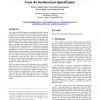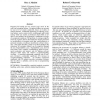60 search results - page 11 / 12 » Post-Silicon Debug Using Programmable Logic Cores |
107
click to vote
SIGARCH
2008
14 years 11 months ago
2008
Conventional programming models were designed to be used by expert programmers for programming for largescale multiprocessors, distributed computational clusters, or specialized p...
ICCD
2007
IEEE
15 years 8 months ago
2007
IEEE
Building fully synchronous VLSI circuits is becoming less viable as circuit geometries evolve. However, before the adoption of purely asynchronous strategies in VLSI design, globa...
105
click to vote
ESOP
2001
Springer
15 years 4 months ago
2001
Springer
Programmers rely on the correctness of the tools in their programming environments. In the past, semanticists have studied the correctness of compilers and compiler analyses, which...
116
click to vote
FPGA
2003
ACM
15 years 4 months ago
2003
ACM
One of the most difficult and time-consuming steps in the creation of an FPGA is its transistor-level design and physical layout. Modern commercial FPGAs typically consume anywher...
125
click to vote
FTCS
1998
15 years 1 months ago
1998
Programs fail mainly for two reasons: logic errors in the code, and exception failures. Exception failures can account for up to 2/3 of system crashes [6], hence are worthy of ser...


